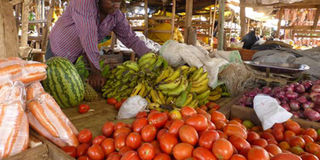Those funny looking fruits and veggies are gold

Isiolo market chairman Mr James Gitonga sells fruits and vegetables at an open market along the Isiolo- Marsabit highway on April 26,2016. There is an important reason why we should pick and use or sell all of the different types and kinds of fruits and vegetables, whatever their appearance or “processing standard of acceptance”. PHOTO | VIVIAN JEBET | NATION MEDIA GROUP
What you need to know:
- According to National Geographic magazine (March 2016), “about a third of the planet’s food goes to waste”.
- Kenya needs to set up Affirmative Action projects for women, youth, and the disabled to use all of the “funny-looking fruits and vegetables” in bakeries, in restaurants, in shelters and food banks.
- By using all of the food that is produced in Kenya, we could bring the coverage of country-produced food to over 90 per cent of the population and cover as much as 70 per cent of its nutrient needs.
There is an important reason why we should pick and use or sell all of the different types and kinds of fruits and vegetables, whatever their appearance or “processing standard of acceptance”.
Those funny-looking fruit and vegetables, some which arise due to our interference with winds, bees and birds, are the answer to improving nutrition.
According to National Geographic magazine (March 2016), “about a third of the planet’s food goes to waste”. This is because we cannot transport fresh foods easily and quickly and can’t store over-age.
This is also because only the most “perfect” crop gets chosen for the large food manufacturers’ operations.
This is called standardising inputs for quality control. In the end, however, it becomes the middlemen who determine the types, appearance, and brand quality of the product that reaches the end consumer and that determines the price and raises the bar on what is acceptable to a consumer.
All of the “funny-looking” fruits and vegetables get tossed out.
Kenya needs to set up Affirmative Action projects for women, youth, and the disabled to use all of the “funny-looking fruits and vegetables” in bakeries, in restaurants, in shelters and food banks.
URBAN PROFESSIONALS
What Kenya could use right now are hundreds and hundreds of new producer-consumer cooperatives that focus on matching sellers and buyers of nutrient-rich, colourful, organic, and diverse foods regardless of their appearance or “imperfections”.
I am proud to say that we see local NGOs across Kenya realising that there are numerous ways to utilise the full capacity of its farmers. There are NGOs like Kickstart helping on the irrigation side; there are other companies bringing in appropriate technology from India to improve processing efficiencies; there are groups organising farmers’ cooperatives to sell their produce directly to consumers, directly to retailers, processors, or distributors, and/or to sell at home in the local village.
By using all of the food that is produced in Kenya, we could bring the coverage of country-produced food to over 90 per cent of the population and cover as much as 70 per cent of its nutrient needs.
In the end, it is up to urban professionals with the most disposable income to choose to buy Kenyan produced fruits and vegetables of the highest nutritional value and up to farmers to produce and cultivate high quality, organic, fresh produce to satisfy an increasingly educated and demanding clientele.
***
Mrs Feller is an international development specialist and may be reached at: [email protected].




